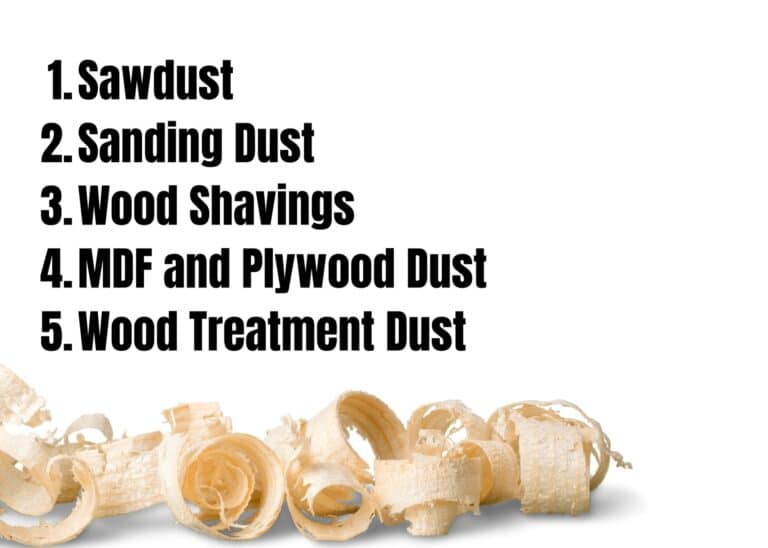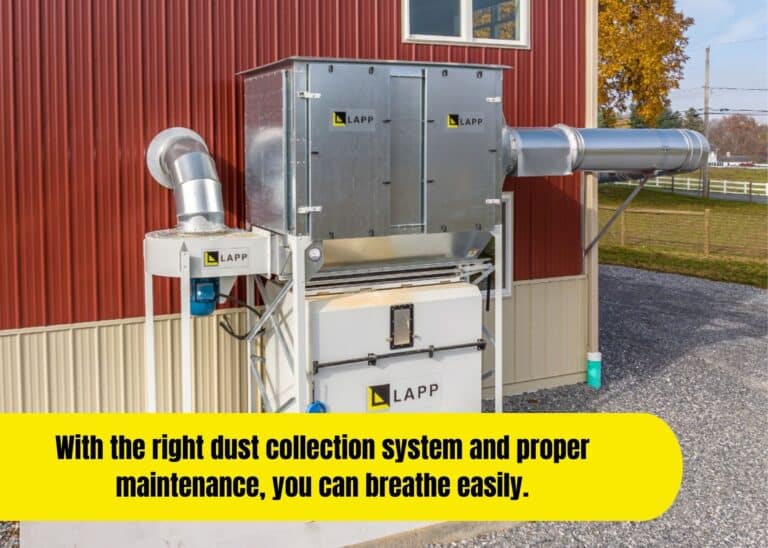In the world of woodworking, a silent menace often goes unnoticed: dust.
Picture this: finely powdered wood, metal shavings, or even chemical particles swirling in the air, invisible but potent.
Dust in the air is akin to a hidden saboteur. You know this, and we do too. It waits to compromise the well-being of workers, erode the longevity of machinery, and even invite regulatory scrutiny. It’s here that the importance of effectively collecting and removing dust becomes undeniable. This is why we at Lapp Millwright want to help shop owners like yourself uncover the secrets of effective dust control. Ready to dive in?
Fasten your seatbelts as we embark on this essential journey to mastering the fundamentals of dust collection systems.
What Is a Dust Collection System?
If you are in the business of manufacturing — anything from cabinets to RVs to vinyl fences, you are no stranger to the constant battle against dust and debris. While woodworking brings creativity to life, it also generates a significant amount of dust. This poses both health risks to your workers and challenges to the longevity of your equipment.
This is where a system designed to collect and remove dust comes into play. A dust collection system is a crucial tool in your arsenal for maintaining a clean, safe, and efficient work environment.
Defining a Dust Collection System
This system is a comprehensive setup designed to capture, filter, and dispose of dust and debris generated during various manufacturing processes. They are often comprised by a network of ducts, hoods, filters, and collection containers. All these pieces work seamlessly together to keep your workspace clean and safe.
Basically, dust collection systems protect the health of woodshop workers, the equipment and keep woodshop owners on the right side of the law.
Now, maybe this all sounds overwhelming. That’s exactly what we are here for. At Lapp Millwright, we design and maintain custom dust collection systems for your business so that you don’t have to worry about it!
Common Sources of Dust in Woodshops
To fully understand the necessity of collecting and removing dust, we must recognize the common sources of dust in woodshops. Woodworking processes such as cutting, sanding, planing, and routing generate dust in various forms:
- Sawdust
- Sanding Dust
- Wood Shavings
- MDF and Plywood Dust
- Wood Treatment Dust

In short, installing an air filtration system is not just a luxury but a necessity for woodshop owners. It plays a pivotal role in maintaining a clean and safe work environment. Without something collecting and removing dust from the air, you put the health of your employees at risk and shorten the life of your equipment.
Now let’s dive deeper into the inner workings of dust mitigation and explore how to select the right management system for your specific needs.
Understanding the Dust Collection Process
You’ve recognized the importance of keeping your woodshop clean and safe by investing in a system for extracting dust. But how exactly does this marvel of engineering work its magic? Let’s break down the dust collection process into its key stages: capture, filtration, and disposal.
Capture: The First Line of Defense
At the heart of the dust collection process lies the critical stage of capture. This is where dust gets collected at its source. Collecting it at the source ensures it doesn’t have a chance to escape into the air and wreak havoc in your workspace. The collector achieves the capture through a combination of well-placed hoods and ducts that use the power of suction.
Filtration: Cleaning the Air
With dust successfully captured at the source and transported through the ducts, the next stage in the process is filtration. This is where the real magic happens. During this process, filters work diligently to remove dust particles from the airstream.
Disposal: Safely Managing Collected Dust
As the air emerges clean and dust-free from the filtration stage, the final part of the dust collection process begins – disposal. It’s imperative to manage collected dust safely and responsibly.
The dust collection process is a multi-stage journey that captures, filters and disposes of dust particles. If you want to maintain a clean, safe, and productive work environment, familiarize yourself with how each stage operates. With the right dust collection system and proper maintenance, you can breathe easily.

Your woodshop will be a healthier and more efficient space for both you and your employees.
The Importance of Effective Dust Collection
When you are used to woodworking, dust may seem like a minor inconvenience. Yet, dust isn’t just an annoyance; it’s a hidden hazard that can compromise both your woodshop’s health and prosperity. Effective dust collection is not a luxury but a necessity, and here’s why:
1. Worker Health: Breathing Easier in the Workplace
Your woodworking artisans are your most valuable assets, and their health is of paramount importance. Airborne dust, often too small to see with the naked eye, carries with it a multitude of health risks. These risks include allergens, fungi, and, in some cases, even carcinogens. Prolonged exposure to such airborne particles can lead to a host of respiratory issues, allergies, and, potentially, long-term health problems.
A robust dust extraction system is your first line of defense against these health hazards. It captures airborne dust particles at their source, preventing them from infiltrating the air your employees breathe. In essence, it’s an investment in the well-being of your workforce. With a systematic way for collecting and removing dust, you can ensure your employees go home at the end of the day with their health intact.
2. Equipment Longevity: Protecting Your Valuable Assets
Your woodworking machinery represents a substantial financial investment. Their longevity is critical to the success of your woodshop. Dust accumulation may seem harmless, but it’s a relentless adversary that can lead to premature wear and tear.
When dust lands on moving parts, electrical parts, and motors, it harms your equipment. Dust makes machines wear out faster and break down often because it is abrasive. As a result, it leads to more downtime and higher maintenance expenses, and there’s also the possibility of having to buy new equipment.
When you mitigate dust, you don’t just keep your workers safe; you also take care of your expensive machines. A clean, dust-free place makes your machines work better, with fewer problems and a longer life.

This saves you money and lets you concentrate on woodworking instead of fixing machines.
3. Regulatory Compliance: Navigating the Legal Landscape
Running a woodshop comes with duties, including following safety rules. Different places have strict dust control rules for industries, and not following them can lead to big problems.
Good dust extraction isn’t only for health and machine life; it’s also for following laws. These rules keep your workers safe and your business honest. Not following them can result in fines, legal problems, and a bad reputation.
Using a good dust mitigation system makes sure your woodshop follows the law. It shows you care about safety, reducing the chance of legal problems. Following these rules keeps you out of trouble and shows you’re a responsible and ethical woodshop owner.
In short, good dust collection is a must for woodshop owners. It keeps your workers healthy, makes your machines last longer, and helps you follow the law. It’s an investment that leads to a safer, more efficient, and more profitable woodshop. So, prioritize dust collection to breathe easy, protect your equipment, and stay legal in your woodworking space.
By now, you’ve seen the value of a reliable dust collection system. But not just any system will do. Next we’ll address some things to look for when selecting a quality system for your setup.
Things to Look for in a Dust Collection System
The key lies in selecting one tailored to your woodshop’s unique needs and challenges. Here are crucial considerations to guide your choice:
1. System Size and Capacity: Matching the Scale of Your Ambitions
Start by checking how big your woodshop is. Make sure the dust collection system matches the size of your place and how much dust you make. If it’s too small, it won’t work well and can make the air dirty. But if it’s too big, it’s like spending too much money on something you don’t need.
To ensure optimal performance, calculate the airflow requirements of your woodshop. Think about how many machines you have, how big they are, and how much dust they make. A system that fits well not only makes the air cleaner but also makes your machines last longer.
Remember, we at Lapp Millwright can do all of this for you and make sure your bases are totally covered!
2. Type of Dust: Tailoring to Your Craft
Dust is different depending on what you’re working with. It can be tiny wood bits, metal pieces, or chemicals. To catch and control the dust well, your system needs to be right for the kind of dust you have.
Different dust types require different collection methods and filtration techniques. Wood dust, for example, behaves differently than metal filings or chemical particles. Ensure that your system is designed to handle the materials you work with most frequently.
3. Filtration Efficiency: Capturing Every Particle
In dust collection, good filtration is critical. Your system needs to catch all sizes of particles, even the ones you can’t see without a microscope.
Be sure to look for filters with a high Minimum Efficiency Reporting Value (MERV) rating. This indicates their ability to capture fine particles. High-efficiency filters are your first line of defense against the finest dust. These pose health risks and equipment wear.
4. Maintenance Requirements: Nurturing Longevity
Taking care of your system is like looking after your woodworking tools. Regular care makes sure it works its best. If you neglect maintenance, it can lead to reduced efficiency and costly repairs.
Different systems need different care, so be aware of what yours needs. Make sure you can properly maintain it, and create a plan to check and clean your filters regularly. If they’re really dirty, replace them. Taking care of it helps it last longer and keeps your workspace clean all the time.
5. Compliance with Standards: Meeting Legal and Regulatory Obligations
Running a woodshop means you have to follow rules about how your dust extraction system should work and be designed. Learn the rules about dust control for woodshops in your area and in your industry.

Make sure your system is as good as or better than what the rules say. This way, you avoid problems with the law and legal issues.
6. Cost Considerations: Balancing Investment and Returns
Even though buying a dust collection system can seem expensive at first, think of it as an investment. It pays off over time. You’ll save money because your equipment lasts longer. You won’t spend as much on repairs, and your workers can get more done. Plus, you’ll retain the good ones longer! So, it’s not just a cost; it’s an investment that helps your woodshop succeed and last.
Picking the right system makes your woodshop safer and more efficient. It also makes your equipment last longer and helps you follow the law. So, make a smart choice, spend your money wisely, and watch your woodshop do well in a clean and dust-free space where creativity can flourish.
Conclusion
Now that you know what a dust collection system is and how to determine which one you need, why not take the next step? We would love to help you create a healthier, safer, and more productive workspace.
Dust collector services we offer include:
- Industrial dust systems
- Economy dust systems
- Smoke & fume collection
- Industrial filters
- Service & repairs
- Preventative maintenance programs
- Ductwork systems
- Bucket Elevators
Our estimation process is simple and free. We design and fabricate the collection system for your specific needs.
Reach out today and let us help you clean your workspace air and lengthen the life of your machines!





